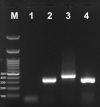First report of filarial nematodes in the genus Onchocerca infecting black flies (Diptera: Simuliidae) in Iran
- PMID: 37666968
- PMCID: PMC10477325
- DOI: 10.1038/s41598-023-41890-z
First report of filarial nematodes in the genus Onchocerca infecting black flies (Diptera: Simuliidae) in Iran
Abstract
Black flies are blood-sucking insects of public health importance, and they are effective vectors of pathogens and parasites, such as filarial nematodes of the genus Onchocerca. Our previous surveys have shown that individuals of Simulium turgaicum are annoying pests of humans and livestock in the Aras River Basin of Iran. In the present study, adult black flies of S. turgaicum were trapped from different ecotopes of five villages in Khoda-Afarin County, Iran. By using a sensitive nested PCR assay and targeting the nuclear 18S rDNA-ITS1 marker, filarial infections were found in 38 (1.89%) of 2005 black flies. Homology exploration of 360 bp of the sequences indicated that the filarial worms are members of the family Onchocercidae, with maximum alignment scores of 93-95%. Phylogenetic analysis showed that two Iranian Onchocerca isolates were clustered in the O. fasciata-O. volvulus lineage and were well separated from other filarial nematodes. Both the entomological evidence (empty abdomen of the specimens) and climatologic data (adequate accumulated degree days for development) suggest that the filarial DNA was probably that of infective larvae of vertebrates. This is the first report of an infection by Onchocerca species in S. turgaicum and the first record of onchocercids in black flies in Iran; however, more research is required to demonstrate transmission of these filarial worms by black flies in nature.
© 2023. Springer Nature Limited.
Conflict of interest statement
The authors declare that they have no conflict of interest. The laboratory and field costs of this study were funded by N.M-R. and K.Kh., respectively. The study was also conducted after the first author graduation from the master's course in entomology and independently from any institution or financial support of another person.
Figures



Similar articles
-
Molecular detection of Dirofilaria spp. and host blood-meal identification in the Simulium turgaicum complex (Diptera: Simuliidae) in the Aras River Basin, northwestern Iran.Parasit Vectors. 2020 Nov 4;13(1):548. doi: 10.1186/s13071-020-04432-4. Parasit Vectors. 2020. PMID: 33148310 Free PMC article.
-
Diversity of nematodes infecting the human-biting black fly species, Simulium nigrogilvum (Diptera: Simuliidae) in central Thailand.Acta Trop. 2021 Dec;224:106140. doi: 10.1016/j.actatropica.2021.106140. Epub 2021 Sep 23. Acta Trop. 2021. PMID: 34562429
-
Black flies (Diptera: Simuliidae) of the Aras River Basin: Species composition and floral visitation.Acta Trop. 2020 Sep;209:105536. doi: 10.1016/j.actatropica.2020.105536. Epub 2020 May 23. Acta Trop. 2020. PMID: 32450136
-
Blackfly vectors of zoonotic onchocerciasis in Japan.Med Vet Entomol. 2012 Dec;26(4):372-8. doi: 10.1111/j.1365-2915.2012.01023.x. Epub 2012 Jul 25. Med Vet Entomol. 2012. PMID: 22827756 Review.
-
Viruses in Simuliidae: An Updated Systematic Review of Arboviral Diversity and Vector Potential.Life (Basel). 2025 May 19;15(5):807. doi: 10.3390/life15050807. Life (Basel). 2025. PMID: 40430233 Free PMC article. Review.
Cited by
-
A filarial parasite potentially associated with the health burden on domestic chickens in Japan.Sci Rep. 2024 Mar 15;14(1):6316. doi: 10.1038/s41598-024-55284-2. Sci Rep. 2024. PMID: 38491072 Free PMC article.
References
-
- Adler PH, McCreadie JW. In: Medical and Veterinary Entomology. 3. Mullen GR, Durden LA, editors. Academic Press; 2019. pp. 237–259.
-
- Khanzadeh F, Khaghaninia S, Maleki-Ravasan N, Koosha M, Oshaghi MA. Molecular detection of Dirofilaria spp. and host blood-meal identification in the Simulium turgaicum complex (Diptera: Simuliidae) in the Aras River Basin, Northwestern Iran. Parasites Vectors. 2020;13:548. doi: 10.1186/s13071-020-04432-4. - DOI - PMC - PubMed
-
- WHO. Onchocerciasi Key Fact (Geneva). Available at: https://www.who.int/news-room/fact-sheets/detail/onchocerciasis (2022).
Publication types
MeSH terms
LinkOut - more resources
Full Text Sources

